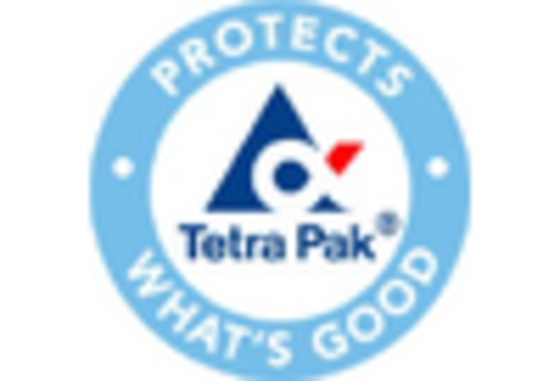Corporate Sustainability Initiatives
The Eco Friendly Packaging Market is significantly influenced by corporate sustainability initiatives. Many companies are recognizing the importance of integrating sustainability into their business models, leading to increased investments in eco-friendly packaging solutions. A report suggests that over 50% of major corporations have set ambitious sustainability goals, which often include the adoption of eco-friendly packaging. This trend is not merely a response to consumer demand but also a strategic move to enhance operational efficiency and reduce costs associated with waste management. By prioritizing sustainable packaging, companies can improve their supply chain resilience and reduce their environmental footprint. This alignment of corporate strategy with sustainability objectives is likely to propel the Eco Friendly Packaging Market forward, as more businesses seek to demonstrate their commitment to environmental stewardship.
Technological Advancements in Packaging
The Eco Friendly Packaging Market is benefiting from rapid technological advancements in packaging materials and processes. Innovations such as plant-based plastics, compostable films, and smart packaging solutions are emerging, providing companies with a diverse array of eco-friendly options. These advancements not only enhance the functionality of packaging but also reduce environmental impact. For example, the development of biodegradable materials has the potential to significantly decrease landfill waste. As technology continues to evolve, the Eco Friendly Packaging Market is likely to see an influx of new products that meet both consumer expectations and environmental standards. This ongoing innovation is crucial for maintaining competitiveness in a market that increasingly values sustainability.
Consumer Demand for Sustainable Products
The Eco Friendly Packaging Market is experiencing a notable surge in consumer demand for sustainable products. As awareness of environmental issues grows, consumers are increasingly seeking packaging solutions that align with their values. Research indicates that approximately 70% of consumers are willing to pay more for products packaged in eco-friendly materials. This shift in consumer behavior is compelling companies to adopt sustainable packaging practices, thereby driving growth in the Eco Friendly Packaging Market. Brands that prioritize sustainability not only enhance their market appeal but also contribute to a positive brand image, which is crucial in today's competitive landscape. Consequently, businesses are investing in eco-friendly packaging options to meet this rising demand, indicating a significant trend towards sustainability in the packaging sector.
Growing Awareness of Environmental Impact
The Eco Friendly Packaging Market is experiencing growth driven by increasing awareness of environmental impact among consumers and businesses alike. As information about the detrimental effects of plastic pollution becomes more widespread, stakeholders are more inclined to seek sustainable alternatives. Surveys indicate that a significant percentage of consumers are actively looking for products with eco-friendly packaging, which in turn influences purchasing decisions. This heightened awareness is prompting companies to reevaluate their packaging strategies and invest in sustainable solutions. The Eco Friendly Packaging Market is thus positioned to expand as businesses respond to this growing consciousness, aligning their practices with the values of environmentally aware consumers. This trend suggests a long-term shift towards sustainability in packaging, which could reshape industry standards.
Regulatory Support for Eco-Friendly Practices
The Eco Friendly Packaging Market is bolstered by increasing regulatory support for eco-friendly practices. Governments worldwide are implementing stringent regulations aimed at reducing plastic waste and promoting sustainable packaging solutions. For instance, several countries have introduced bans on single-use plastics, which has prompted manufacturers to explore alternative packaging materials. This regulatory environment creates a favorable landscape for the Eco Friendly Packaging Market, as companies are incentivized to innovate and adopt sustainable practices. The potential for compliance with these regulations not only mitigates legal risks but also enhances brand reputation among environmentally conscious consumers. As regulations continue to evolve, the demand for eco-friendly packaging solutions is likely to expand, further driving growth in the industry.


















Leave a Comment